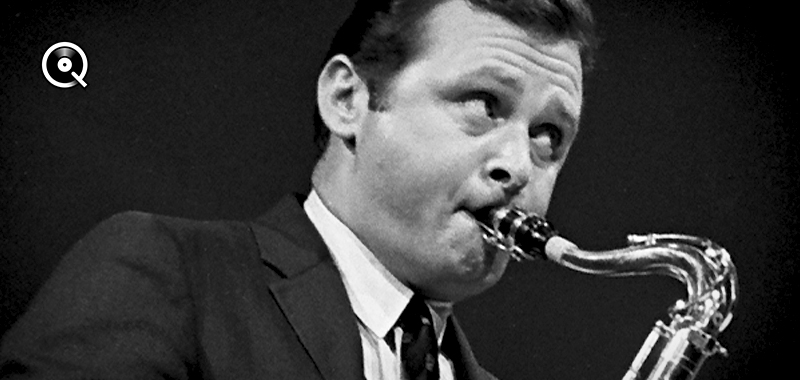This “great works” approach to the music’s history gives glory to the hallowed texts. But it overlooks the vital “mulch” of improvised music – the days spent practicing and composing, the ordinary nights in half-full clubs testing out material with various combinations of musicians. Those workshopping opportunities are necessary for evolution: None of the music’s legendary disruptors traveled express from peak to peak. Everyone instead went door to door, playing in clubs and touring. Refining ideas. Testing things out. Stretching. And sometimes failing.
This recently unearthed live document – which was professionally recorded and intended for release, but wound up sitting in a vault for 58 years – helps shed light on the ways Stan Getz, the artistically restless tenor saxophonist, managed and cultivated his muse.
Like many of the music’s trailblazers, Getz operated on parallel tracks, balancing creative lunges against career considerations. He’d show up at places like the Village Gate and do pretty much what his audience expected – rip through standards and jazz tunes that had been in his repertoire for more than a decade. But then, out of the public eye, he was immersed in an entirely different pursuit – chasing new sounds and approaches in the recording studio, concocting unconventional and still somewhat misunderstood projects.
This dynamic pretty much defines Getz in 1961 – a year of pivots and experiments that led to some of his most challenging works as well as some of his most commercially successful endeavors.
When Stan Getz appeared at the Village Gate in November 1961, it was months after his return to active performance in the U.S., and he apparently felt he still had stuff to prove. He’d spent three years living in Copenhagen, and during that time away his stature as a pre-eminent tenor saxophonist was challenged by the fast-rising John Coltrane. Some have suggested Getz returned to the US because he was nervous about slipping out of the top spots in jazz magazine polls.
At the Village Gate and on other recordings from around the same time, Getz sounds like he’s exploring new dimensions of his playing, and maybe even trying to make listeners forget the easygoing velvet-toned aura of his 1950s recordings. He’s more agitated – check out the odd bugle-call outbursts on the brisk Airegin – and a bit more of a show-off. At times he seems cartoonishly audacious, alternating between intricate bebop carving and boisterous big-band-style riffs that land with a lashing-out intensity.
Still, inevitably, there are ballads, a Getz specialty. These display his knack for uncovering the hidden slopes and shapes of a melody, and then transforming that theme through blithe, carefree, seemingly small musings. One highlight among several: The gorgeously pensive reading of Spring Can Really Hang You Up the Most on disc 2. It’s jazz ballad mastery.
The visceral spirit of the music on the Gate date contrasts powerfully with the music Getz was preparing in the studio. He returned from Europe with big plans, kick-starting a frenzy of recording while seeking out different kinds of records to make. First he convinced Verve to issue At Large, which he’d recorded with a small group while in Copenhagen.
Then he persuaded the label to help realize an ambitious project: A seven-part suite entitled Focus, written by arranger Eddie Sauter, blending tense classical orchestration with jazz improvisation. Getz followed that with another studio date, the blandly titled Recorded Fall ‘61. This features the rhythm section heard on Getz at the Gate – pianist Steve Kuhn, bassist Jon Neves, drummer Roy Haynes – playing clever and unfailingly pleasant charts by valve trombonist Bob Brookmeyer.
Then, not even a month after the Village Gate engagement, Getz teamed up with guitarist Charlie Byrd for an experiment they called Jazz Samba – the first of many forays into the Brazilian music that made Getz a crossover star when The Girl From Ipanema exploded in 1963.
It’s interesting to think about those recordings – and to be sure, Focus and Getz/Gilberto are both peak-achievement hall-of-fame works – while listening to Getz at the Gate.
There are no traces of the experiments Getz has been undertaking, or hints of the left turn he’s about to make. But there’s a pronounced restlessness in the tenor solos, the sound of one who is being compelled to push past convention.
There’s something else, too – the sense that this chorus-by-chorus effort on this one night is part of a larger ongoing thing, possibly a quest. You can tell the other musicians are swept along and inspired by it, magnetized by Getz’ presence. In the crisp and spirited renderings of It’s Alright With Me and It’s You Or No One it’s possible to hear Kuhn stretching the edges of the accompanying harmony that Getz expects. Then Getz reacts to that by stretching in a different way, and then Haynes – a timekeeping minimalist with a knack for unexpected drama – stirs that interaction up in a way that galvanizes all involved, and just pries the music wide open.
That is, of course, what people come to jazz for – the moment when what seemed ordinary at the start becomes a sparkling and majestic mountaintop in full sunshine. Stan Getz got there by pursuing sometimes weird, daunting, conceptual ideas. And as this set shows, he also got there on routine nights in clubs, wrestling with the familiar and lifting business-as-usual to unexpected, exceptional heights.




